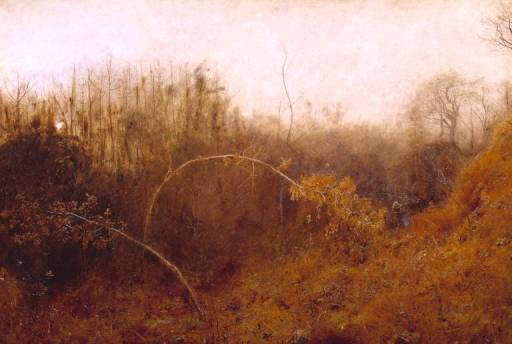By R M Billingham
The Somerset countryside has always been a landscape artist’s paradise but it was unknown to many of the greatest painters of the nineteenth century, and was never immortalised by a major artist such as Constable whose inspiration was the Suffolk countryside. But in 1860 one young illustrator penetrated the rural depths of West Somerset; he was John William North who was then eighteen years old, and it was the beginning of a life-long association with the area. He stayed at Halsway Manor near Crowcombe and returned there several times, and he has left us a portrait of the house before it was restored, in an illustration he designed for a gift book called “A Round of Days”. He also stayed at the nearby hamlet of Woolston Moor, and then years later, in 1884 settled in Somerset and stayed until his death in 1924, though he had several different homes, notably Beggearnhuish House near Washford.
In his lifetime North was respected as both painter and illustrator and in both media his best work expresses the pastoral delights of the countryside. A number of his illustrations were engraved in wood by both Swain and the Dalziel brothers, the best craftsmen of the day, and appeared in illustrated gift books. He was also respected as a colourist by contemporary art critics, and was considered a master of watercolour techniqu
e. Several eminent artists, around them Sir Hubert Herkomer, RA, visited him in Somerset to seek his advice.
Although much of North’s work, like the oil painting Summer
in a Western Wood of 1907/8, is redolent of the
West Country, not many of his pieces are specifically topographical. One interesting exception to this is the large watercolour view of Taunton he painted in 1880. The
conventional foreground may be painted from memory, but the view across the River Tone is clearly taken from the site of the present county cricket ground and shows the churches of St Mary and St James.
North did not often depict easily recognisable landmarks, and the titles of his exhibited paintings do not usually refer to specific places: Little Rivers Rising in the West, and Spring in a Western Orchard are typical examples. He frequently painted his immediate environment, such as Stanborough Farm of 1922, a charming if rather escapist interpretation of the remote smallholding that was his home. At Woolston Moor he painted the Old Yew Tree; his daughter remembers that he was fascinated by the way one tree was growing out of another. That North loved studying trees is shown in his illustrations to an article called Summer in Somerset by Richard Jeffries which were published in “The English Magazine” in October 1887. The sketches of Exford and Minehead are dull, but that of Holford Glen, a sylvan scene, is much more alive. Some of his poetic illustrations were designed twenty years earlier; about the time he drew Halsway. A design prepared for the Religious Tract Society illustrating “Lo, the winter is past, the rain is over and gone”, is a typical expression of his country world, in which we get no sense of agricultural poverty, or of the sweat of the brow. He had plenty of sympathy with the farmer’s life, and was politically active on their behalf, but he also admired William Blake, and if he lacked that poets’ inspiration he nevertheless saw the countryside with an idealized vision.
North was one of the last Romantics in the true nineteenth century sense of the term. Much of his work concerns communion with nature, and this attitude of mind is aptly summed up in an illustration of his published in 1867 in the magazine “Once an Week”. A solitary figure, very similar to the one who appears in the picture of Halsway, looks away from the spectator, and contemplates the countryside around her. In his later life, North, too, looked away from the events of his own time. There is no trace of a knowledge of twentieth century art movements in his work; still less is there any hint of the tragedy of the Great War, or even of the personal loss he suffered when his daughter died of diptheria in 1897. He was a fair-weather countryman who viewed his scenes in Summer and sunlight. His emotional range was limited but his lyricism was suited to the gentle landscape of West Somerset, which he knew well, and portrayed faithfully.



Do you know where the painting of Halsway is now?
Posted by Laura Woodland | July 4, 2012, 9:46 amI’m sorry Laura, the painting is in the hands of a private collector who wishes to remain anonymous.
Posted by The Idyllists | August 3, 2012, 3:12 pm